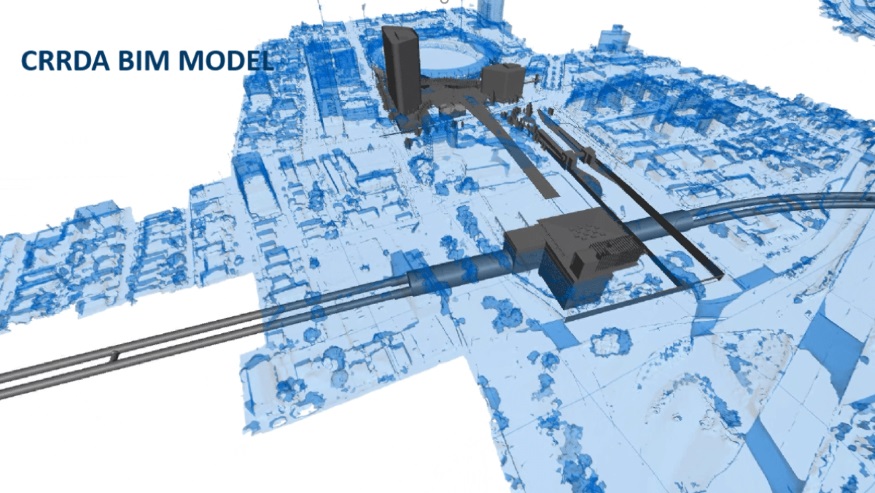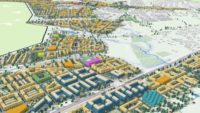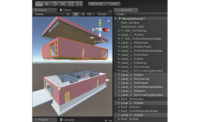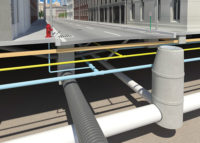In Australia’s fastest growing city, the future begins underground.
By 2036, the South East Queensland metro area will add another 1.5 million residents—a number that, by itself, would be Australia’s fifth-largest city.
Most new arrivals will settle outside Brisbane, the capital of Queensland, an area already facing a housing crunch.
Although the population of outlying areas like Ipswich and Gold Coast will also swell, most of the new job creation will likely occur in Brisbane’s central business district. The number of trains necessary to handle the commuter influx via existing bridges would cause constant backups and bottlenecks.
To alleviate these stresses, Queensland is banking on Cross River Rail (CRR), a $4-billion transit project scheduled for completion in 2026. The centerpiece of CRR involves the construction of Brisbane’s first subway: 3.7 miles of twin tunnels under the Brisbane River and four underground stations throughout the CBD.
Making Way for Brisbane’s First Subway
The Cross River Rail Delivery Authority recognized the enormous challenges of constructing a new subway underneath an already dense and thriving downtown. So, CRR planners sought advice from the team building Crossrail in the UK. The British project, which began construction in 2009 and is now nearing completion, has similar aims and scope, linking Central London and London’s suburbs via ten new underground stations.
CRR’s team had one burning question for their Brit counterparts: what would they do differently if they could begin again today?
“They basically said they would’ve built a bigger, better 3D model sooner,” said Russell Vine, CRR’s chief innovation officer. In other words, they would have built a digital twin of the project.
A digital twin for infrastructure projects serves several purposes. In the planning stages, it lets architects, planners, and designers try out various scenarios. During construction, the twin becomes a living record of the process, tracking progress and noting any problems. Once the project is done, the digital twin serves as a way to test possible future developments before making any real-world changes. It can even be used for operational and maintenance purposes.
The timing of CRR places the project on the cusp of a digital twin revolution. Planners and architects have discovered how geographic information system (GIS) technology can interface with building information modeling (BIM) to create digital twins that are realistic and scalable.
Building on Lessons Learned
In their planning discussions, Crossrail had three major suggestions for the CRR team.
First, require all contractors to submit BIM plans in the same standardized format. That would allow visual details of every component of CRR’s built environment—from an escalator’s motor to a length of track—to fit together, like a 3D jigsaw puzzle, creating a “federated” BIM model.
By itself, this exhaustive BIM model would form a digital twin of CRR, but one that lacked context. BIM imagery just depicts inert components floating in space. A true digital twin would show how this model exists among its environment.
The Crossrail team’s second policy prescriptive would facilitate this broader contextual awareness. They urged CRR to place all project-related datasets—GIS, BIM, volumetric, photogrammetry, anything else—into a central GIS repository. GIS could depict the 3D space in which the federated model resides, including any existing surrounding infrastructure, such as pipes and cables.
Seeing Above and Below Ground
The idea to create a central repository served another purpose for CRR.
The Cross River Rail Delivery Authority’s charter requires the organization to plan for and assess the economic impact the project will have on areas surrounding the stations.
“Cross River Rail is going right under the CBD, so the area around the stations is already prime land where the city will grow next,” Vine said.
One of the most high-profile examples is 101 Albert Street, a 40-story mixed-use building that will rise on the CRR Albert Street Station’s lot.
Architectus, the Australian firm that designed the project with Danish architects Henning Larsen, highlights the way tropical foliage hanging off the terraces will evoke the city’s “unique subtropical climate and youthful culture.” When viewed from the station, the tower “will appear as a subtropical vertical garden, with seamless transitions between indoor and outdoor spaces.”
To visualize the plans for both Albert Street Station and 101 Albert Street, the CRR team extended their digital twin to include the city itself. Using LiDAR and other methods, they created a detailed 3D map of the central business district, providing a framework for understanding CRR’s effect on Brisbane.
Adding a 3D Gaming Tool to a Digital Twin
Crossrail’s third recommendation was “the party piece, the one everybody loves,” Vine said, because it’s about making the model immersive. “They told us they should’ve put all their data into a game engine and turned it into virtual reality.”
The Australian team did just that, using Unreal Engine, a 3D gaming tool that can access GIS data to make immersive maps.
“So, we have a federated BIM model of all the stations and all the tunnels, and GIS land mapping in 3D,” Vine said. “But then we put it all into Unreal, crank the magic gaming engine handle, and it gives us back a single virtual reality.”
The result is 10-and-a-half miles of immersive railway infrastructure that can be explored on a screen, like a first-person game, manipulating a web scene or with a virtual reality headset. The Cross River Rail team even built a virtual reality theater using a five-way projection system, so that many people can explore the project together.
The virtual reality experience provides a way for non-technical stakeholders—people not directly involved with the design and construction of CRR—to view the project as it proceeds. It also gives those who are part of the design team the kind of visual assessments that even the most detailed 3D BIM model cannot provide. As one example, Vine points to the Roma Street station, where teams are experimenting with ways to install a massive art exhibition space on a concourse wall, testing different ideas before they finalize the design.
The digital twin can grow in perpetuity, evolving with Brisbane itself. Since CRR construction began, Brisbane was picked to host the 2032 Summer Olympic Games. Vine predicts the digital twin will help prepare the city. “We have an opportunity to take what we’ve done here as part of building a railway line and stretch it to include everything we’re going to need to build for the Olympics.”
The twin could also be used to help run and maintain CRR as the stations open and the trains begin to run, saving teams from having to recreate all their asset data. Once the project is complete, the digital twin can be seamlessly incorporated into maintenance systems. “We have a running joke about Cross River Rail,” Vine said. “The more you look at it, the bigger it gets.”





Post a comment to this article
Report Abusive Comment